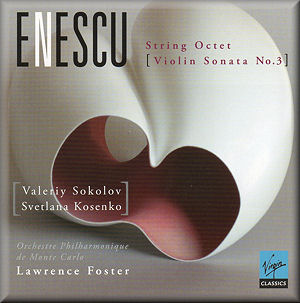 |
 |
|


alternatively
CD: AmazonUK
AmazonUS
|
Georges ENESCU
(1881–1955)
String Octet in C, op.7 (1900) (orchestral version by Lawrence Foster)
[40:54]
Violin Sonata No.3 in D, Dans le charactère populaire roumaine,
op.25 (1925) [23:07]
 Monte Carlo Philharmonic Orchestra/Lawrence Foster (Octet)
Monte Carlo Philharmonic Orchestra/Lawrence Foster (Octet)
Valeriy Sokolov (violin), Svetlana Kosenko (piano) (Sonata)
rec. 7–12 January 2008, Auditorium Rainier III, Monaco DDD
 VIRGIN CLASSICS 5129312 [65:01]
VIRGIN CLASSICS 5129312 [65:01] 
|
|
|
Enescu’s String Octet is a big work in one movement,
where the whole structure completes a sonata form movement;
the opening Très modéré constitutes the exposition, the
Très fougueux is a scherzo, the Lentement the
development and the final Mouvement de valse bien rythmé
is the recapitulation. This is exactly what Schönberg attempted
in his 1st String Quartet some
four years later. The Octet is richly and thickly scored,
and, as an octet, it poses many problems of balance. With that
in mind, I wonder why Lawrence Foster chose to orchestrate the
work. Foster is a well known exponent of Enescu’s music, and
has recorded the three Symphonies, Vox maris, the Chamber
Symphony and much else, including the opera Oedipe,
and he has given excellent performances of these works. However,
the Octet is another matter. Foster uses a big string
section and there is a constant feeling of muddiness, on account
of there simply being too many players. Some works transcribe
easily from one medium to another – Beethoven’s own version
of his 2nd Symphony for piano
trio or any of Ravel’s orchestrations of his own piano works.
There are many more which totally resist transcription – Alkan’s
Symphonie and Concerto for solo piano, for instance,
and this Octet. There is one other problem. The room
in which the Octet was recorded is a richly reverberant
space and this does the Octet no favours when it comes
to trying to follow the argument. In all honesty, with such
good Enescu recordings to his credit, I wonder how, and why,
Foster made this miscalculation.
The 3rd Violin Sonata, subtitled
In the character of Roumanian popular style, is imbued
with the spirit of a country fiddler. Enescu has caught the
very spirit of the gypsy; the Sonata is a homage to the
gypsy and to his music. Many violinists have attempted this
work, and many have failed to understand the music and get to
the heart of the work. The best of all the recordings was by
Enescu himself. He understands the hallucinatory, improvisational,
quality of the inspiration and allows himself time to play each
phrase, using rubato freely and expressively, in a real folk
manner. The nearest to Enescu, for my money, is André Gertler
on an old Supraphon LP (SUA 10483). Valeriy Sokolov is a very
fine player but he approaches this work with too light a hand,
which leaves the music without any heart or real power. One
wants more than a mere reading of the notes. The recording is
better than that given to the Octet, and it is bright
and clear, but this doesn’t make up for some rather bland playing.
I cannot recommend this disk. Sokolov and Foster fail to penetrate
to the heart of this elusive music.
Bob Briggs
|
|

